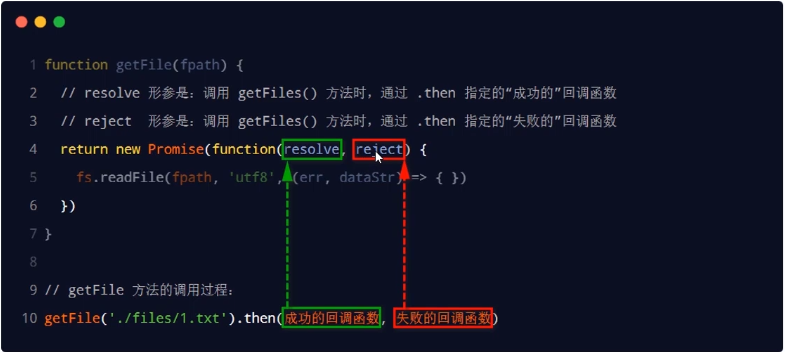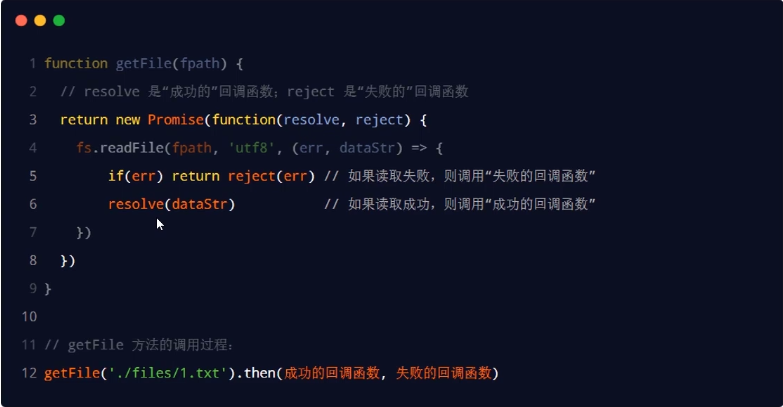一 概述
通过.catch方法捕获错误
Promise.all和Promise.race方法的使用
基于Promise封装异步读文件的方法
二 通过.catch方法捕获错误 2.1 当文件名错误时,没有任何的错误及结果(不存在文件名111.txt) 1 2 3 4 5 6 7 8 9 10 11 12 13 14 15 import thenFs from 'then-fs' thenFs .readFile('./files/111.txt', 'utf8') .then((r1) => { console.log(r1) return thenFs.readFile('./files/2.txt', 'utf8') }) .then((r2) => { console.log(r2) return thenFs.readFile('./files/3.txt', 'utf8') }) .then((r3) => { console.log(r3) })
2.2 通过 .catch 捕获错误 在 Promise 的链式操作中如果发生了错误,可以使用 Promise.prototype.catch 方法进行捕获和处理
1 2 3 4 5 6 7 8 9 10 11 12 13 14 15 16 17 18 19 import thenFs from 'then-fs' thenFs .readFile('./files/111.txt', 'utf8') .then((r1) => { console.log(r1) return thenFs.readFile('./files/2.txt', 'utf8') }) .then((r2) => { console.log(r2) return thenFs.readFile('./files/3.txt', 'utf8') }) .then((r3) => { console.log(r3) }) .catch((error) => { console.log(error) })
执行node运行后,错误信息如下:
1 2 3 4 5 6 [Error: ENOENT: no such file or directory, open 'D:\Code\Vue3\day1\es601\files\111.txt'] { errno: -4058, code: 'ENOENT', syscall: 'open', path: 'D:\\Code\\Vue3\\day1\\es601\\files\\111.txt' }
2.3 catch提前捕获错误 如果不希望前面的错误导致后续的 .then 无法正常执行,则可以将.catch 的调用提前 ,示例代码如下
1 2 3 4 5 6 7 8 9 10 11 12 13 14 15 16 17 18 import thenFs from 'then-fs' thenFs .readFile('./files/111.txt', 'utf8') .catch((error) => { console.log(error) }) .then((r1) => { console.log(r1) return thenFs.readFile('./files/2.txt', 'utf8') }) .then((r2) => { console.log(r2) return thenFs.readFile('./files/3.txt', 'utf8') }) .then((r3) => { console.log(r3) })
说明:
捕获readFile发生的错误,并输出错误的消息
由于错误已被及时处理,不影响后续.then的正常执行
三 Promise.all和Promise.race方法的使用 3.1 Promise.all() 方法 Promise.all() 方法会发起并行的 Promise 异步操作,等所有的异步操作全部结束后 才会执行下一步的 .then
1 2 3 4 5 6 7 8 9 10 11 import thenFs from 'then-fs' const promiseArr = [ thenFs.readFile('./files/1.txt', 'utf8'), thenFs.readFile('./files/2.txt', 'utf8'), thenFs.readFile('./files/3.txt', 'utf8'), ] Promise.all(promiseArr).then(result=>{ console.log(result) })
打印结果:
3.2 Promise.race() 方法 Promise.race() 方法会发起并行的 Promise 异步操作,只要任何一个异步操作完成,就立即执行下一步的 (赛跑机制)。示例代码如下
1 2 3 4 5 6 7 8 9 10 11 import thenFs from 'then-fs' const promiseArr = [ thenFs.readFile('./files/1.txt', 'utf8'), thenFs.readFile('./files/2.txt', 'utf8'), thenFs.readFile('./files/3.txt', 'utf8'), ] Promise.race(promiseArr).then(result=>{ console.log(result) })
打印结果:
四 基于Promise封装异步读文件的方法 4.1 封装getFile方法
方法的名称要定义为 getFile
方法接收一个形参 fpath ,表示要读取的文件的路径
方法的返回值 为 Promise 实例对象
4.2 getFile 方法的基本定义 1 2 3 function getFile(fpath) { return new Promise() }
说明: new Promise() 只是创建了一个形式上的异步操作
4.3 创建具体的异步操作 如果想要创建具体的异步操作 ,则需要在new Promise() 构造函数期间,传递一个function 函数,将具体的 。示例代码如下
1 2 3 4 5 6 7 function getFile(fpath) { return new Promise(function (resolve, reject) { fs.readFile(fpath, 'utf8', (error, data) => { }) }) }
4.4 获取 .then 的两个实参 通过 .then() 指定的成功 和失败 的回调函数,可以在 function 的形参中 进行接收,示例代码如下
4.5 调用 resolve 和 reject 回调函数 Promise 异步操作的结果 ,可以调用 resolve 或 reject 回调函数进行处理。示例代码如下
1 2 3 4 5 6 7 8 9 10 11 12 13 14 15 16 17 18 19 20 import { error } from 'console' import fs from 'fs' function getFile(fpath) { return new Promise(function (resolve, reject) { fs.readFile(fpath, 'utf8', (error, data) => { if (error) return reject(error) resolve(data) }) }) } getFile('./files/1.txt').then( (r1) => { console.log(r1) }, (error) => { console.log(error) } )

